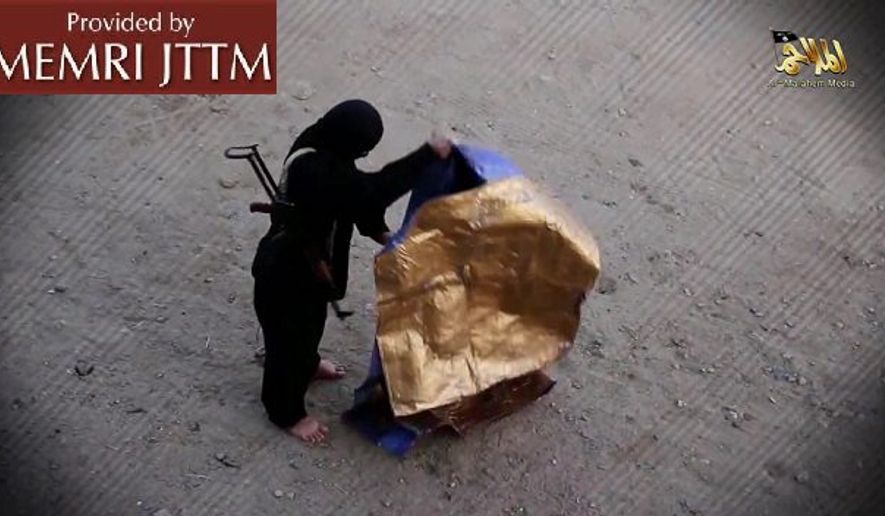The most dangerous al Qaeda affiliate to the U.S. homeland is teaching fighters how to avoid detection by the Predator drone, the terrorist group’s feared assassin flying over Yemen.
Al Qaeda in the Arabian Peninsula has produced a video that shows fighters a step-by-step process for making and using a portable body wrap.
It claims the insulation will prevent the Predator’s infrared cameras from detecting a human’s heat signature. By day, a camouflage version will hide them from the same prying eyes, says the video posted last month to a jihadi Twitter account.
Whether the homemade shield actually works is unclear. But AQAP’s instructional video is an example of how violent extremists are studying American tactics — many of them openly on display in the media — and then trying to counter them.
In this case, AQAP has taken official Defense Department video of the Predator, its spying pods and generic bomb-camera footage to drive home this point: If it can’t see you, it can’t strike with a Hellfire missile.
A spokesman for U.S. Central Command, which runs military operations in Yemen, said, “For operational security reasons, we wouldn’t discuss the possible effectiveness or ineffectiveness of specific enemy [tactics, techniques and procedures] nor would we speculate on how they derive their information.”
PHOTOS: Top 10 U.S. fighter jets
Strategic analysts express doubt that 13 years of drone strikes are reversing AQAP gains in Yemen.
But to some degree, the fact that the terrorist group sees a need to produce a counterdrone video shows the strikes are effective in harassing and killing AQAP fighters and top leaders. Of all the al Qaeda affiliates, Washington views AQAP as the one most determined to attack America.
“One part of their military strategy is to distribute videos and information to followers online, particularly via Twitter and YouTube, showing that they are actively engaged in countering the impact drones have had on their capabilities,” said Steve Stalinsky, executive director of the Middle East Media Research Institute. The Washington nonprofit tracks jihadi communications and has analyzed the how-to video.
AQAP’s 16-minute “Combating Spy Airplanes” is not a slick production. Rather, it is part arts-and-crafts show and part science project, spliced together with U.S. military public relations videos.
The segment, for example, that explains a person’s heat signature uses the scene of a lab worker heating up a frozen dinner in a microwave oven.
Production of one insulation wrap: a body-size tarp is spread on the floor. A paint brush smears it with glue. Basic supermarket aluminum foil is pressed against it. Then more glue and another tarp to form sort of an aluminum sandwich.
PHOTOS: Stars and Stripes: Celebrities who served in the military
On screen, a fighter re-creates hearing or seeing a U.S. drone overhead and quickly huddling inside the insulation.
“The aluminum is supposed to act like a heart barrier, keeping the fighter’s body heat from being detected by the drone camera system,” says an analysis by the Middle East Media Research Institute.
The insulation can be enhanced by attaching tree branches and painting a camouflage pattern. It also can be folded for easy carrying.
The video’s last two minutes are devoted to showing how convoys should seek cover once an airplane is seen or heard.
Months after al Qaeda’s Sept. 11, 2001, attacks on the U.S., President George W. Bush made Yemen a battlefield. Yemen presented an example of why Mr. Bush launched a global war. Al Qaeda was exploiting the country’s ungoverned tribal areas, such as it did in Pakistan, to create another base from which to attack the United States and to try to bring down a weak government.
The first big shot was in November 2002, when a CIA-operated Predator assassinated a high-ranking al Qaeda planner, Ali Qaed Senyan al-Harthi, and five others as they moved in a jeep across the desert. The precision showed U.S. intelligence agencies were fast learning how to find and track extremists — in this case by following cellphone signals.
President Obama has greatly increased the strikes as AQAP rose up and aspired to duplicate the terrorist capabilities of al Qaeda headquarters in Pakistan as the mother ship lost key leaders to capture and assassinations.
AQAP has assembled some of the terrorist world’s best technicians at making bombs that could be secreted onto passenger jets. Those technicians are top CIA targets. Press reports said two of them were killed in a drone strike in November.
The U.S., after only a handful of strikes in Yemen through much of the 2000s, launched 41 alone in 2012, 26 the next year and 23 last year, according to Longwarjournal.org.
The biggest strike in Yemen was not in numbers but in significants. In September 2011, a Hellfire missile killed Anwar al-Awlaki, a charismatic American-born cleric whose mystical social media skills summoned recruits to Yemen and inspired Muslims to kill “infidels.”
Still, analysts look at the map of Yemen and see AQAP still making gains against a hard-pressed local security force.
A brazen AQAP released a propaganda video last year of a huge gathering of fighters, assembled in the open, being addressed by the leader himself, Nasir al-Wuhayshi.
“Our long drone war against AQAP has been remarkably ineffective,” said Robert Spencer, who directs JihadWatch.org. “Awlaki was killed, but AQAP now controls much of Yemen and acts at will there. They are clearly not cowed, not afraid, not on the defensive.”
• Rowan Scarborough can be reached at rscarborough@washingtontimes.com.




Please read our comment policy before commenting.